AICRP on Cotton, Akola
|
|
 |
||
|
|
|||
|
|
|||
|
|
|||
|
Scientists |
|||
About Station
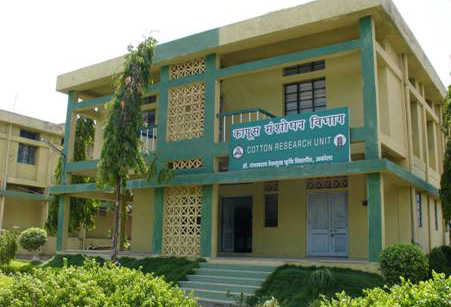
The world textile industries are being ruled by “King Cotton”. The antiquity of cotton has been traced to the fourth millennium BC. The fabric pieces from “Mohenjodaro” excavations were found to made up of cotton. For over three thousand years (1500 BC to 1700 AD), India was recognized as cradle of cotton industry. India thus enjoys the distinction of being the earliest country in the world to domesticate cotton and utilize its fibre to manufacture fabric. India is the 2nd largest producer of cotton in the world. India accounts for approximately 25 per cent of world’s cotton area and 16 per cent of total cotton production. Maharashtra is the important cotton growing state in India with 31.33 lakh ha area and production of 62.00 lakh bales (2008-09).
About 3 million farmers are engaged in cotton cultivation in the state mostly in backward region of Marathwada and Vidarbha. Cotton enjoys a free eminent status among all cash crop in the country, being a principal raw material for a flourishing textile industry which accounts for nearly 20 per cent of the total national industrial production and provides employment to over 15 million people.
In Vidarbha region, cotton is the most important cash crop grown on an area of 13.00 lakh ha with production of 27 lakh bales of cotton (2008-09). The productivity of cotton is low (350 kg/ha) in Vidarbha as compared to national (502 kg/ha). The main reason for the low productivity of cotton in Vidarbha is its dependence on the monsoon rain and about 95 to 98 per cent area is under rain-fed cultivation.
The “Cotton Research Unit” was established in the university with inception of ICAR centre under “All India Coordinated Cotton Improvement Project” in 1972 for development of high yielding varieties and hybrids of American and Deshi cotton suitable for rain-fed situation of Vidarbha region and development of low cost cultivation technology along with effective and cheapest plant protection measures.
“All India Coordinated Cotton Improvement Project” (AICCIP) started at Cotton Research Unit, and another scheme “Integrated Cotton Development Project” (ICDP) was also sanctioned by state government since 1978 to strengthen the research work on cotton.
Agro Climatic Information
Akola is situated at an elevation of 307.4 meter above the mean sea level at 220 42’ North latitude and 770 02’ East longitude and has subtropical climate. Normal rainfall of 0.2 mm in 41.2 rainy days received at Akola centre. Rainfall received during four months i.e. June to Sept. maximum temperature ranges between 29.0 0C to 47.2 0C. April, May and 1st week of June are the hottest period in which temperature ranges between 33 0C to 44 0C. However, in the month of December and January maximum temp is below 30 0C. The minimum temp ranges between 10.3 to 27.6 0C. Bright sunshine hours ranges between 3.3 to 8.8 hours in rainy season sunshine hours are less (3.3 to 4.5 hours) wind speed in the range of 4.9 to 9.1 km/hour during January to April, However, it is more onwards April up to Sept. (10 to 16.2 km/hour). Relative humidity 10 % during summer and maximum in Rainy season i.e. 88 %. Evaporation rate is maximum during summer (17.3 mm/day) and minimum in the month December and January (402 to 5.2 mm day).
Infrastructure
The Cotton Research Unit, Dr. PDKV, Akola has well developed infrastructural facilities like,
- Twenty four hector land is allotted to Cotton Research Unit.
- Soil chemistry laboratory at office building.
- Own independent Office building at Central Research Station campus.
- Field laboratory and field office are under construction and will be completed soon.
- Tractor (one) for farm cultivation.
- Jeep (one) for monitoring multilocation trials, seed production plots and visiting the farmers’ field.
- Various instruments required during the research by different disciplines.
- Computer Unit, Fax and Xerox machines are available.
Mandate
-
To develop high yielding varieties and hybrids suitable for rainfed situation in Vidarbha region.
-
To develop suitable Agro-techniques to achieve maximum yield and monitory benefit.
-
To develop effective and cheapest plant protection schedule.
Objectives
-
Test different cotton varieties and advanced breeding lines for its suitability and their screening for location specific adaptability
-
Identify and develop varieties of cotton of the region for resistance to pests and diseases, early maturity and drought tolerance characteristics
-
Improve cotton crop productivity for better monetary return by developing suitable cropping systems under given farming situation
Projects Operating at Station
-
Development and promotion of medium and long linted diploid cottons (G.arboreum and G.herbaceum)
-
Development and promotion of Bt transgenic cotton for bollworm resistance.
-
Development of production technologies for Bt cotton and improvement of water and nutrient use efficiency with precision farming techniques.
-
Development and validation of IPM, IRM strategies for conventional and Bt cotton under different ecosystem.
-
Nucleus and breeder seed production of cotton varieties and parents of hybrids.
-
Insect pest resistance management.
-
National information system for pest management-Bt-cotton.
Research Activities and Achievements
Cotton Breeding
-
Fundamental research including the interspecific breeding by use of wild species of cotton such as G. anomalum, G. raimondii, G. thurberi, G. aridum, etc. was carried out to enlarge the gene pool and to find out the suitable sources of male sterility for heterosis breeding programme and to introgress the various characters.
-
Breeding for clean seeded characters: Development of high yielding clean seeded varieties to facilitate high oil recovery, easy processing and to avoid mechanical delinting in both deshi and American cottons.
-
Breeding for high yielding superior medium to long staple cotton varieties in both deshi and American cottons.
-
Breeding for high ginning percentage and big boll varieties of both G. hirsutum and G. arboreum cottons.
-
Heterosis breeding programme for the development of high yielding medium/long staple, short/long duration American cotton hybrids with resistant/tolerane to major pests, diseases and drought using available male sterile sources (CMS/GMS).
-
Heterosis breeding for development of high yielding medium to long staple deshi cotton hybrids based on male sterility techniques.
-
Breeding for tolerance/resistance to different pests and diseases in diploid and tetraploid cottons.
-
Breeding for high g/tex at 3.2 mm gauge tenacity in hirsutum varieties and hybrids
-
Development of suitable for mechanical/rainfed cultivation in both American and arboreum cottons.
-
Improvement of fibre properties in diploid cotton.
-
Evaluation of advanced breeding material for incorporation in Multilocation trials.
-
Conduct of University, State and National Multilocation trials.
Cotton Entomology
- Screening of breeding material for their recognition against pest of cotton
- Development of suitable, economic and effective pest control measures for major pests of cotton.
- Observations on the occurrence of key pests of cotton.
Cotton Agronomy
-
Optimization of nutrient requirement and plant geometry for Bt cotton.
- Agronomic requirement of promising / pre-released / recently released hirsutum and arboretum genotypes.
-
Foliar application of nutrients on growth and yield of Bt cotton.
-
Management of leaf reddening in Bt cotton.
-
Agronomic evaluation of Bt cotton hybrid under varied crop geometry and NPK levels under rainfed conditions.
-
Integrated rain water and nutrient management for improvement in productivity and fibre quality of Bt cotton.
-
Precision application of irrigation and fertilizer through drip on productivity and fibre quality of Bt cotton.
-
Synchronising N and K supply with Bt cotton demand to enhance fertilizer use efficiency.
-
Studies on soil olant narrations in intercropped kharif legumes with Bt cotton under rainfed conditions.
-
Evaluation of various modules for cotton production.
-
Evaluation of various products in relation to cotton production.
-
Maximization of yield potential of various released / promising varieties and hybrids of cotton.
Cotton Pathology
-
Screening of cotton breeding material against major and minor diseases of cotton.
-
Epidemological studies on cotton diseases in farmer’s and research farms.
-
To find out suitable and effective disease control measures through integrated disease managements.
Research Achievements
- Evolution of new genetic male sterility in Gossypium arboreum diploid cotton.
To ease the hybrid seed production in diploid cotton male sterility is one of the means for utilization of heterosis. At present only two sources of genetic male sterility in deshi cotton are available, one from Hisar and onther from Dr. P.D.K.V., Akola which is developed by utilizing a wild species G. anomalum. This new source of genetic male sterility is utilized for the development and release of two hybrids viz, PKV DH-1 released in 2002 and PKV Suvarna (AKDH-5) released in 2006. This new genetic male sterility system has been utilized for the diversification of 87 GMS lines for the heterosis-breeding programme.
- Diversification of CMS using G.harknessii source.
Diversified large number of cytoplasmic male sterile lines and restorers developed in G.harknessii background in tetraploid cotton. In G.harknessii cytoplasm stable 55 CMS lines and 23 restorers were developed and are being utilized in hybrid breeding programme.
- Development and utilization of alternate source of CMS.
In cotton, G.harknessii is the only source for cytoplasmic male sterility. Therefore there may be danger of uniformity and narrow genetic base. To overcome these problems, the attempt was made at Dr. PDKV, Akola to develop alternate source of cytoplasmic male sterility in cotton and successfully developed an alternate source of cytoplasmic male sterility in tetraploid cotton by using a wild species, G.aridum. By using this alternate source of cytoplasmic male sterility diversified 11 stable CMS lines and one restorer line of good agronomic base have been developed.
- Utilization of GMS in tetraploid cotton.
The digenic genetic male sterility has been used for the development of GMS lines in tetraploid cotton and diversified three genetic male sterile lines for the heterosis-breeding programme in tetraploid cotton.
- Development of introgressed lines using wild species.
The wild species G.anomalum , G.raimondii , G.thurberi and G.aridum have been used in diploid and tetraploid cotton for the enhancement of gene pool having high yielding potential, resistance to biotic and abiotic stressesm, good fibre qualities and identification and incorporation of marker genes into inbred lines.
- Lines registered
The CMS Line CAK-84635 A (PKV Rajat) and its maintainer AK-84635 B have been registered with NBPGR, New Delhi as a Genotype with G.aridum cytoplasm Vide registration no, INGR. No.04046 and National Identities IC – 296639 and IC-296640, respectively. In addition to all the released cotton varieties and parents of hybrids registered.
Research Recommendations (Approved in AGRESCO)
The various recommendations have been given by the various disciplines while working with the cotton. These recommendations are useful from the farmers’ point of view. The discipline wise recommendations made from the inception of the project are as given below,
Cotton Agronomy
A. Sowing Time:
-
Pre monsoon irrigated cotton should be sown between 20th to 30th May.
-
Dry Sowing of straight varieties were found beneficial to increase Seed Cotton Yield over monsoon sowing.
-
For monsoon sowing, early sowing between 24th and 25th meteorological week (11th to 24th June) was found optimum. Early sowing with commencement of monsoon rains is desirable. Delay in sowing from optimum time of sowing even by a week reduces the seed cotton yield to the extent of 10 to 20 per cent.
-
Under limited availability of water, this Cotton Research Unit has developed a low cost technology popularly known as ‘crow-bar technology’ through which sowing can be achieved with least amount of water. This technology gives 70 to 100 per cent more yield than monsoon sowing. This technique was further refined and recommended as below:
a) Apply one third of Nitrogen and full dose of P2O5 and K2O of the recommended dose (100:50:50 Kg NPK ha-1) at the time of sowing and remaining Nitrogen in two equal splits (30 and 60 days after sowing).
b) It was also found that 40 per cent reduction in water application did not significantly reduce the yield over normal crow-bar method. -
Raising of cotton seedlings in polythene bags and subsequently transplanting in the field after commencement of monsoon increased the cotton yield by 40 per cent as compared to monsoon sowing.
B. Planting Pattern and Plant Population:
-
Paired row planting (90 X 30 cm) of Hirsutum cotton with 50 Kg Nitrogen + 25 Kg P2O5 ha-1 with 56 thousand plants per hectare gave optimum yield of seed cotton.
-
A dwarf and early duration variety AKH 081 responded well to higher plant population. Hence spacing of 60 X 15 cm is recommended for this variety.
-
For getting maximum seed cotton yield a sowing distance of 60 X 30 cm and fertilizer dose of 50:25:0 NPK kgha-1 are recommended to Hirsutum cotton variety PKV Rajat (AKH 84635)
-
For cotton hybrid CAHH 468 a sowing distance of 60 X 90 cm and fertilizer dose of 50:25:25 NPK kgha-1 are recommended under rainfed condition.
-
Under rainfed condition sowing distance of 60 X 60 cm and fertilizer dose of 50:25:25 NPK kgha-1 are recommended to American cotton hybrid PKV Hy 4 and PKV Hy 5.
-
A sowing distance of 60 X 15 cm and fertilizer dose of 30:15:0 NPK kgha-1 are recommended to Arboreum cotton verities AKA 5, AKA 7 and AKA 8 for getting maximum seed cotton yield under rainfed condition.
-
For mechanical cultivation a seeding distance of 96 X 30 cm is recommended to improved cotton variety PKV Rajat for getting maximum yield under drip irrigation.
C. Soil and Rain Water Management:
-
Method of paired row planting with opening of deep furrows at 60 to 70 days after sowing was effective in increasing the yield. The method of ridging with every inter-culture was also beneficial.
-
On sloppy land sowing on ridges on 0.2 per cent slope gave more yield than sowing across the slope.
-
Opening of furrows (after two rows) at seeding or at 30 days after sowing is essential for improving moisture status of the soil and boosting crop yield in both contour sowing and sowing across the main slope.
-
From the toposequance study of micro water shed, it was observed that on a sloppy field instead of growing cotton crop on entire field, it is profitable to take cotton on upper toposequance (80 % area) and soybean – chick pea crop sequence on lower toposequance (20 % area).
-
In shallow soil (soil depth less than 22 cm) it is recommended to sow a dwarf and early cotton variety AKH 081 at 60 X 15 cm spacing for getting higher seed cotton yield under rainfed condition instead of cotton hybrids and other varieties.
6. Two protective irrigations at flowering and boll setting increased the yield by 16.8 per cent over no protective irrigation treatment.
D. Fertilizer Management:
-
A fertilizer dose of 100:50:50 NPK kgha-1 is recommended for getting maximum seed cotton yield of irrigated hybrid cotton (pre-monsoon sowing).
-
Under rainfed condition a fertilizer dose of 50:25:25 NPK kgha-1 is recommended for hybrid cotton.
-
For Hirsutum straight varieties a fertilizer dose of 50:25:0 NPK kgha-1 is recommended
-
A fertilizer dose of 30:15:0 NPK kgha-1 is recommended for Arboreum varieties.
-
Basal dose of fertilizer should be applied at the time of sowing. If delayed by 15 and 30 days, reduced the yield by 6.0 and 14.3 per cent respectively.
-
A spot application of manures and fertilizers (RDF) to cotton crop is advantageous.
-
Fertilizer application by ring method or spot application at three places increased the yield by 12.2 and 10.5 per cent respectively as compared to broadcasting method.
-
Among the various Nitrogen management practices half of the recommended N at sowing and half at square formation recorded maximum seed cotton yield and cost benefit ratio of rain fed cotton.
E. Integrated Nutrient Management:
-
Inoculation of seed with azotobactor bio-fertilizer recorded 7.9 per cent increased seed cotton yield of deshi cotton variety AKA 8401 than control. The treatment having recommended dose of Nitrogen gave 11.0 and 29.3 per cent higher seed cotton yield respectively over 75 per cent and 50 per cent recommended Nitrogen application.
-
Application of FYM @ 5 t ha-1 along with low fertilizer dose of 25:12.5 N and P ha-1 is recommended for cotton variety AKH 081 grown under shallow soil (less than 25 cm) to get maximum monetary benefit in rainfed condition.
-
An application of 50 per cent RDF (25:12.5 kg N and P ha-1) and either FYM or glyricidia green foliage lopping at 30 days after emergence @ 5 tha-1 is recommended to get higher seed cotton yield and net monetary returns with the added benefit of improving physico-chemical properties of soil under rainfed condition.
-
An organic and in-organic fertilizer experiment of treatment having recommended dose of fertilizer (RDF) recorded more yield followed by 50 per cent RDF + 5 t FYM ha-1 and 50 per cent RDF + glyricidia foliage lopping compared to other treatments. Organic manure resulted in increasing organic carbon content and available N and P2O5 content of soil.
F. Weed Management:
-
A critical period of weed crop competition was found to be as 3 to 9 weeks after sowing during which it is necessary to keep the crop weed free for getting higher yield. A loss in seed cotton yield under unweeded control was to the extent of 85 per cent when compared with normal hand weeding.
-
Normal weeding and inter-culture recorded maximum seed cotton yield. A Pre and post emergence spray of diuron weedicide @ 0.75 kg ha-1 was effective in controlling weeds as compared to other chemical weed control treatments.
-
For control of weeds and increase in seed cotton yield application of 1.5 kgha-1 of pendemethalin or fluchloralin combined with one weeding or one hoeing at 30 days after sowing is recommended.
-
Fluchloralin @ 1.5 kg a.i.ha-1 + one hoeing 30 days after sowing is recommended for weed control in cotton – green gram interculturing system.
G. Intercropping:
-
Intercrops like green gram, black gram, soybean and groundnut reduced the yield of seed cotton as compared to sole cotton crop. Yield reduction was more with soybean as intercrop. Groundnut and green gram were observed to be the good intercrops in cotton (AHH 468) for getting maximum monetary returns.
-
Green gram and black gram are identified as suitable intercrops in Arboreum cotton variety AKA 8401 (90 X 20 cm spacing).
-
The seed cotton yield was maximum in sole cotton crop and it was reduced by 9.3, 24.6 and 50.5 per cent when intercropped with black gram, green gram and soybean respectively. However GMR was higher in cotton + green gram and cotton + black gram as compared to sole cotton in variety PKV 84635 (Rajat).
-
Sowing of black gram and green gram as intercrops in early and dwarf cotton variety AKH 081 is recommended to get higher monetary returns.
H. Cropping System Research:
-
For getting higher monetary returns and meeting the need of food, fodder and fuel of farmers cotton + sorghum + pigeon pea + sorghum (6:1:2:1) three tier intercropping system is recommended under rainfed situation.
-
Cotton + green gram (1:1) intercropping system recorded higher GMR than sole crop
-
Intercropping in cotton variety MCU 5 with green gram and cowpea with recommended dose of fertilizer to cotton crop was found beneficial on monetary basis as well as for yield stability
-
Cotton – groundnut (summer) crop sequence gave highest net returns and has been recommended for getting higher monetary returns under irrigated condition with adequate inputs.
I. Crop Canopy Management:
-
Two sprays of 2 per cent urea concentration with planofix (1 ml in 4.5 litre water) at flowering and boll formation stages found to be promising for getting higher yield.
-
Two sprays of planofix (NAA) at the commencement of flowering and 50 per cent flowering should be given to get high yield of seed cotton.
-
Foliar spraying of 2 per cent urea at flowering and 2 per cent DAP at boll development stages recorded maximum hybrid seed production followed by two sprays of urea 2 per cent + DAP 2 per cent combination.
-
In detopping experiment it was observed that seed cotton yield under manually detopping of PKV Rajat at flowering and no detopping were statistically similar under rainfed situation. Spraying of cycoceal did not show favourable influence in respect to seed cotton yield, however plant height was significantly reduced by 14 to 29.6 per cent with the use of cycoceal. Spraying of 20 ppm NAA and 2 per cent urea at flowering and 2 per cent DAP at boll development stages produced 16.7 and 18.3 per cent higher seed cotton yield over control. Cycoceal spraying treatment resulted in maximum square production but boll retention percentage was maximum with detopping treatment.
-
For cotton crop 4.5 ppm available iron content in soil and 281 ppm in youngest mature leaf at square initiation stage be considered as critical levels for application of iron.
Cotton Entomology
A. Economic Importance:
The yield losses caused by sucking pests, bollworm, bollworms and sucking pests were 4.61 per cent, 51.30 per cent and 51.53 per cent respectively indicating the importance of control of bollworms in cotton production.
B. Chemical Control of Pests:
1. Sucking Pests:
-
Effective control of jassids could be obtained by the use of 0.1 % carbaryl followed by 0.04 % malathion + 0.1 % carbaryl in combination.
-
While studying the performance of new insecticides against sucking pests of cotton it was observed that Helitox (0.2 %), Phosphamidon (0.02 %), Monocrotophos (0.03 %) and Carbaryl (0.2 %) were found promising amongst the insecticides tried.
-
Monocrotophos 0.06 % was found to be most effective in controlling the nymphal population of aphids, jassids and thrips in cotton.
-
ETL based spraying of Dimethoate 30 EC @ 10 ml OR Methyl Demeton 25 EC @ 8 ml OR Acetamiprid 20 SP @ 1.5 g mixed in 10 liters of water effectively control aphid, jassids and thrips population.
-
ETL based spraying of Methyl Demeton 25 EC @ 40 ml OR Monocrotophos 36 EC @ 28 ml OR Dimethoate 30 EC @ 33 ml OR Triazophos 25EC @ 10 ml OR Fenpropethrin 50 EC@ 10 ml mixed in 10 liters of water effectively control white fly population.
2. Bollworms:
-
Application of monocrotophos at 0.1 % and 0.12 % was found effective in controlling bollworms of cotton.
-
Quinalphos 0.05 %, Carbaryl 10.0 % dust @ 20 kg ha-1, Sevimol 0.2 %, Phosalon 0.05 % dust @ 20 kg ha-1, Monocrotophos 0.06 %, Dicrotophos 0.05 % and Tamaron 0.1 % were found effective in controlling the bollworms of cotton.
-
From the studies to see the efficacy of modern synthetic pyrethroids in comparison with Carbaryl (0.2 %) against bollworm of cotton (Variety H – 4), the treatment with Cypermethrin (0.01 %) was the best followed by Fenvalerate (0.01 %), Decamethrin (0.0025 %), Permethrin (Permasect) 0.01 % and Permethrin (Ambush) 0.01 % in order of merit.
-
Spraying of synthetic pyrethroids alternated with organo-phosphates was recommended for the control of bollworm complex on cotton on the basis of trials conducted for three years.
-
Studies on the efficacy of newer insecticides against cotton bollworm (Variety PKV Hy 2) indicated that the treatment with Flucythrinate (0.005 %) was the best followed by decamethrin (0.002 %) and fenpropethrin (0.015 %) and were at par with each other.
-
Alphamethrin 25 g. a.i. per hectare was recommended for control of bollworm complex on cotton.
-
Spraying of Spinosad 45 SC @ 0.01 % for the management of American and spotted bollworm on cotton and beta-cyfluthrin 2.5 EC @ 0.0025 % for the management of pink bollworm is recommended
C. Integrated Pest Management:
- From the studies on determination of economic threshold level of bollworm on cotton variety L 147 (Rainfed) it was concluded that 5 per cent injury level should be the basis for giving insecticidal treatment against bollworms.
- The economic threshold level for bollworms on cotton variety AHH 468 was worked out to be 5 per cent and it was recommended that 5 per cent injury level of bollworms should be taken into consideration in protecting the cotton crop from bollworm attack.
- It was recommended that the following plant protection packages should be adopted as eco- friendly and economical for effective integrated management of pests of hybrid cotton:
a) Imidacloprid 70 WS seed treatment @ 10 gm / kg seed before sowing
b) One spray of recommended systemic insecticide for sucking pests based on ETL if required
c) Two releases of Trichogramma chilonis egg parasitoid @ 1.5 lakh per hectare at 45 to 50 and 55 to 60 days after sowing
d) One spray of HaNPV @ 500 LE per hectare
e) One spray of neem seed extract 5 %
f) Need based one or two sprays of recommended insecticides for bollworms based on ET level. - For effective, efficient and economical integrated pest management in rain fed cotton following revised IPM module was recommended:
a) Thiomethoxam 70 WS seed treatment @ 4.28 gm/kg seed before sowing
b) One spray of Acetamiprid 20 SP @ 15 g a.i. / ha for sucking pests based on ET level
c) Two releases of Trichogramma chilonis egg parasitoid @ 1.5 lakh per hectare at 45 to 50 and 55 to 60 days after germination
d) For bollworms ETL based one spray each of Azadirachtin 300 ppm @ 5 ml / L, Spinosad 45 SC @ 50 g. a.i. / ha and beta-cyfluthrin 2.5 EC @ 0.0025 %
D. In General Chemical Control:
-
Six sprayings of insecticide + fungicide (Copper Oxychloride 50 WP @ 0.25 %) was found beneficial in protecting cotton crop from pests and diseases.
-
EC formulations were found superior to ULV formulations in reducing the bollworm damage and recording higher yield per hectare.
Cotton Pathology
A. Survey
Bacterial blight followed by grey mildew of cotton were found as major leaf spot diseases of hirsutum cotton. The arboreum group was least affected by bacterial blight but found highly susceptible to grey mildew. The alterneria and mirothecium leaf spot were observed as minor diseases.
B. Disease reaction
Dahiya disease caused by Ramularia gossypii (speg) cif. can affect G. arboreum, G. hirsutum, G. herbaceum, G. barbadense and wild diploid species of cotton showing variable reactions. The disease incidence was observed at 9th, 10th, 11th and 12th week growth stage with maximum at 9th week stage.
C. Host plant resistance
-
During Fusarium wilt screening in artificial epiphytotic conditions 24 different varieties / strains of Akola Centre, AKA 8808 was found moderately resistant. Susceptible reaction was shown by all except AKA 8401 and AKA 8307 where they were found moderately susceptible reaction.
-
While screening 30 promising varieties / hybrids / strains of arboreum and hirsutum group against grey mildew disease in artificial conditions, none was found disease free. Variety DHY 286 was shown moderately resistant reaction during 1991 – 94 screening period.
-
Among 345 hirsutum and 231 arboreum strains screened against bacterial blight none of the strain was found immune to disease.
-
The Israel hybrids screened viz. Eldad, HA 195, Omari, GAHB 202, HA 34 and N 431 were found highly susceptible to collar rot in rainfed conditions and highly susceptible to bacterial blight grown under rainfed as well as in irrigated conditions both.
D. Pathogen race identification
Race No. 10 of bacterial blight caused by Xanthomonas campestris pv malvacearum (now Xanthomonas oxanopodis pv malvacearum) was identified from various varieties / hybrids grown in Cotton Research Unit and at cultivators field.
E. Estimation of losses
Higher yield losses due to grey mildew disease were observed in AKH 4 in artificial inoculated conditions (63.17 %) and in natural conditions (47.54 %). The losses were noticed in PKV Hy 2 (19.64 %) and PKV Rajat (10.17 %) in artificially inoculated conditions. The losses were found negligible in these varieties / hybrids (03.07 % and 01.18 % respectively) in naturally infected conditions.
F. Crop management
-
The disease incidence and intensity of bacterial blight and grey mildew to 60 X 60 cm, 60 X 30 cm and 90 X 20 cm planting pattern used for PKV Rajat did not differ.
-
The differences in disease incidence and intensity of bacterial blight due to 60 X 60, 90 X 60 and 90 X 90 cm with 25:12.5:12.5, 50:25:25 and 75:37.5:37.5 NPK fertilizer dose for hybrids like PKV Hy 2, 3 and 4 were not found significantly even for interaction.
G. Chemical control
-
Dusting of 300 mesh Sulphur 20 kg / ha early in the morning or late in the afternoon for the control of grey mildew.
-
Foliar spray of 0.3 per cent Copper fungicide or Dithane Z-78 or Monocozeb 0.25 per cent for the control of alternaria blight.
-
Foliar spray of Streptocyclin 100 ppm + 0.25 per cent Copper Oxy-chloride for the control of bacterial blight or Foliar spray of Agrimycin – 100, 50 ppm in combination with 0.25 per cent Copper Oxy-chloride for the control of bacterial blight.
-
Seed treatment of 0.1 per cent Carboxine (Vitavax) + 0.3 per cent Thirum for the control of seed borne diseases.
-
Amongst the chemicals tested, foliar spraying of wettable sulphur was found most effective followed by folicur (750 ml / ha) and carbendazim to control the grey mildew with increase in yield.
H. Biological control
-
Foliar spray of bacterial culture No. 12 (Areomonas sp.) and culture No. 51 (Pseudomonas sp.) was found effective to reduce the disease incidence and intensity of bacterial blight next to Streptocycline + Copper Oxychloride as chemical treatment.
-
Foliar spray of 5 per cent neem leaves extract or 5 per cent neem seed extract should be used for the control of bacterial blight of cotton.
Transfer of Technologies
 |
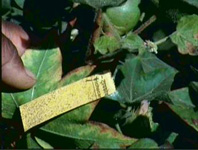 |
 |
For effective, efficient and economical Integrated Pest management in rainfed Cotton following IPM module was recommended.
1. Thiamethoxam 70 WS seed treatment @ 4.28 g/kg seed be fore sowing.
2. One spray of Acetamiprid 20 SP @ 1.5 per 10 litre of water for sucking pests based on Economic Threshold level (ETL)
3. Two releases of Trichogramma chilonis, egg parasitoid @ 1.5 lakh per hectare.
4. For bollworms, ETL Based one spray of azadirachtin 300 ppm @ 5 ml, spinosad 45 SC @ 2.25 ml and beta-cyfluthrin 2.5 EC @ 10 ml per 10 litre of water.
 |
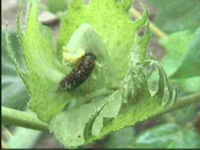 |
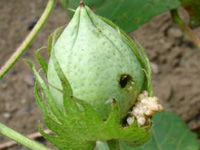 |
Recommendation :
Therefore, for effective management of cotton bollworms, foliar application of spinosad 45 SC @ 2.25 ml per 10 litre of water against american and spotted bollworm and beta-cyfluthrin 2.5 EC @ 10 ml per 10 litre of water against pink bollworm is recommended.
The lowest number of insect that cause economic injury is referred as Economic Injury Level (EIL). The EIL is enable us to identify the population level at which insect cause damage to a crop. Concept of EIL is developed to overcome the problems like insecticide resistance, pest resurgence, insecticide residues and non target effects caused by indiscriminate use of broad spectrum insecticides.
However, application of the chemical insecticides before causing economic injury (damage) to the crop is most important for effective management of pest and to achieve the expected yield. The population density at which control measures should be initiated against an increasing pest population to prevent economic damage and to suppress the pest population below EIL, is often referred as Economic Threshold Level (ETL). ETL is the best known and most widely used index in making pest management decisions.
 |
 |
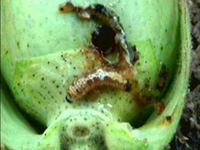 |
Recommendation :
Hence, it is recommended that 5 per cent bollworm damage to the green fruiting bodies should be considered for application of chemical insecticides against bollworm on cotton.
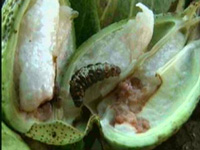 |
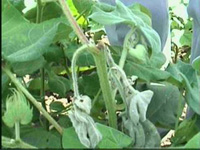 |
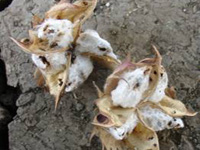 |
Recommendation :
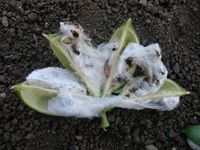 |
 |
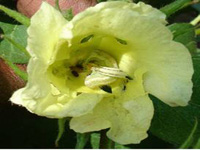 |
Hence, for effective management of cotton bollworms and to obtained higher yield, foliar spray of flucythrinate (0.005 %) followed by decamethrin 2.8 EC (0.002 % ) and fenpropathrin 50 EC (0.015 %) is recommended.
Contact Information
Senior Research Scientist
Cotton Research Unit
Central Research Station
Dr.PDKV, Akola-444 104 (M.S.) India
Telephone Number
Office : 0724 2258176
Field : 0724 2258475
Fax Number
Office : 0724 2258176
e-mail address : srscottonpdkv1@yahoo.com



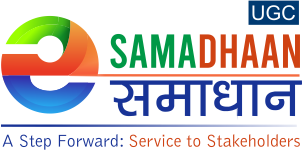


 Krishikosh Repository
Krishikosh Repository



